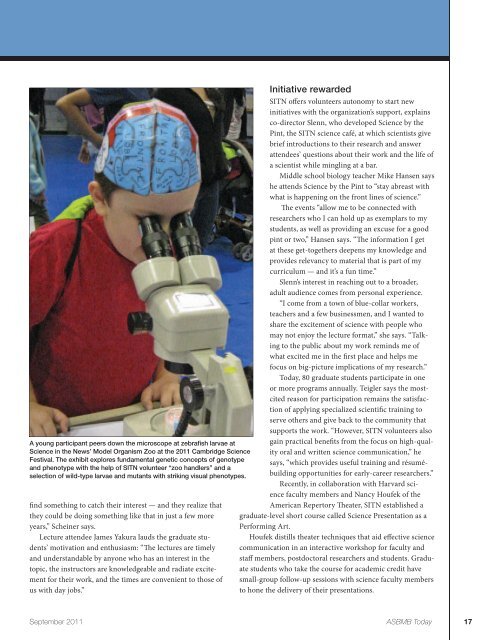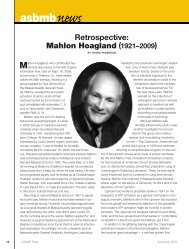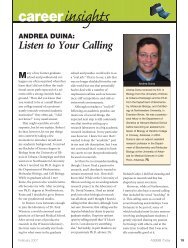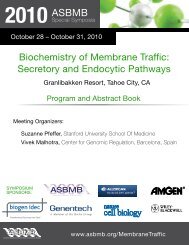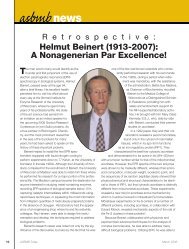asbmbnews
asbmbnews
asbmbnews
Create successful ePaper yourself
Turn your PDF publications into a flip-book with our unique Google optimized e-Paper software.
A young participant peers down the microscope at zebrafish larvae at<br />
Science in the News’ Model Organism Zoo at the 2011 Cambridge Science<br />
Festival. The exhibit explores fundamental genetic concepts of genotype<br />
and phenotype with the help of SITN volunteer “zoo handlers” and a<br />
selection of wild-type larvae and mutants with striking visual phenotypes.<br />
find something to catch their interest — and they realize that<br />
they could be doing something like that in just a few more<br />
years,” Scheiner says.<br />
Lecture attendee James Yakura lauds the graduate students’<br />
motivation and enthusiasm: “The lectures are timely<br />
and understandable by anyone who has an interest in the<br />
topic, the instructors are knowledgeable and radiate excitement<br />
for their work, and the times are convenient to those of<br />
us with day jobs.”<br />
Initiative rewarded<br />
SITN offers volunteers autonomy to start new<br />
initiatives with the organization’s support, explains<br />
co-director Slenn, who developed Science by the<br />
Pint, the SITN science café, at which scientists give<br />
brief introductions to their research and answer<br />
attendees’ questions about their work and the life of<br />
a scientist while mingling at a bar.<br />
Middle school biology teacher Mike Hansen says<br />
he attends Science by the Pint to “stay abreast with<br />
what is happening on the front lines of science.”<br />
The events “allow me to be connected with<br />
researchers who I can hold up as exemplars to my<br />
students, as well as providing an excuse for a good<br />
pint or two,” Hansen says. “The information I get<br />
at these get-togethers deepens my knowledge and<br />
provides relevancy to material that is part of my<br />
curriculum — and it’s a fun time.”<br />
Slenn’s interest in reaching out to a broader,<br />
adult audience comes from personal experience.<br />
“I come from a town of blue-collar workers,<br />
teachers and a few businessmen, and I wanted to<br />
share the excitement of science with people who<br />
may not enjoy the lecture format,” she says. “Talking<br />
to the public about my work reminds me of<br />
what excited me in the first place and helps me<br />
focus on big-picture implications of my research.”<br />
Today, 80 graduate students participate in one<br />
or more programs annually. Teigler says the mostcited<br />
reason for participation remains the satisfaction<br />
of applying specialized scientific training to<br />
serve others and give back to the community that<br />
supports the work. “However, SITN volunteers also<br />
gain practical benefits from the focus on high-quality<br />
oral and written science communication,” he<br />
says, “which provides useful training and résumébuilding<br />
opportunities for early-career researchers.”<br />
Recently, in collaboration with Harvard science<br />
faculty members and Nancy Houfek of the<br />
American Repertory Theater, SITN established a<br />
graduate-level short course called Science Presentation as a<br />
Performing Art.<br />
Houfek distills theater techniques that aid effective science<br />
communication in an interactive workshop for faculty and<br />
staff members, postdoctoral researchers and students. Graduate<br />
students who take the course for academic credit have<br />
small-group follow-up sessions with science faculty members<br />
to hone the delivery of their presentations.<br />
September 2011 ASBMB Today 17


